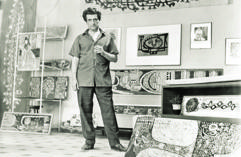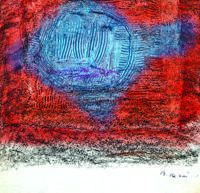Never before seen works of art reveal artist’s life in US
ISTANBUL - Hürriyet Daily News

Bedri Rahmi Eyüboğlu’s paintings, done on Japanese paper, reveal facets of the artist’s artistic life in America. Total of 165 work are revealed in the new exhibition at Akmerkez Shopping Mall.
Turkish artist Bedri Rahmi Eyüboğlu’s never before seen Japanese paperworks, done between 1960 and 1962 while the artist was in America will be exhibited at Akmerkez’s art center.
The exhibition opens Feb. 20 at Akmerkez Shopping Mall with works that detail a certain period of Eyüboğlu’s art career. Japanese paper, known as washi, served as an important material in Eyüboğlu’s career because it helped the artist discover the type of materials that would later hold center stage in his art works and create his own surfaces for his paintings over the years. Total of 165 works of Japanese paper are revealed in the exhibition. The papers are known to be a gift from the American Kellog Family to Eyüboğlu. They are perceived as a valuable example of Eyüboğlu’s artistic talent. While he worked with Japanese paperworks, Eyüboğlu said his perception of art changed.

Organized with the cooperation of Tunca Art, the exhibition aims to reveal details of a period of Eyüboğlu’s career 38 years after his death. The never before seen works are also an important clue about Eyüboğlu’s life in America.
It is known that Eyüboğlu visited the University of California in 1960 as a guest academic and the exhibition’s works were all completed in Berkley, California. During this time, Eyüboğlu opened a new dimension in his career as an artist. As his visit to the United States changed his approach to art, Eyüboğlu began to try new techniques, eventually coming to work and experiment with Japanese paper. Eyüboğlu worked with Japanese paper for two years from 1960 to 1962.
Works on Japanese papers
During his stay at Berkley, Eyüboğlu met with the Kellog Family and an heiress of the family gifted him with the Japanese papers which he began to incorporate into his work. Experimenting with the papers helped Eyüboğlu develop his own surface and material for his art. He loved to work with the papers and created many works with them. For Eyüboğlu, using the papers in his creative process meant freedom.
His visit to America mainly consisted of Japanese paperworks. However, after he used all of his papers he could not afford to buy more because he realized they were really expensive material. Because he had traveled to America with the budget of a university student he didn’t want to use his budget on Japanese papers. Even though he loved the papers and working on them, he did not buy them but instead tried to work on other tissues and paper materials.
Eyüboğlu started to work to create his own materials and surfaces in his painting. He conducted lots of research in the United States, where he also began to work with sands on his canvases. He created new materials using sand and glue and worked spontaneously in his experimentation. As a result he created his own materials in painting.

Later on he started to use carbon papers in different colors such as blue and red and later added white papers to them. He wrinkled the papers, sometimes wetting them, sometimes simply moistening them before opening them to create a surface that he would paint on.
He realized that carbon paper, if used properly, could create the same effects as he’s found Japanese paper could.
Then he drew his favorite motives and shapes, many of which belong to Anatolia and gathered the contrasting colors together on his surfaces. With this he showed his audiences that there is a harmony found between the contrasts.
Sometimes he used fewer colors and created minimal painting, sometimes he used an overwhelming amount of colors, but each time he tried something new. That’s why the period of Eyüboğlu’s career spent in America is a very important part of his art. He reflected his learning on the surfaces that he created. He allowed people to learn new things about paintings at the university he studied at.
After returning to Turkey he used the things he had leaned in America. The portraits and abstract works he created at that time are an important part of his career as his aesthetic also developed during that time.
The exhibition is open until March 24.

 Organized with the cooperation of Tunca Art, the exhibition aims to reveal details of a period of Eyüboğlu’s career 38 years after his death. The never before seen works are also an important clue about Eyüboğlu’s life in America.
Organized with the cooperation of Tunca Art, the exhibition aims to reveal details of a period of Eyüboğlu’s career 38 years after his death. The never before seen works are also an important clue about Eyüboğlu’s life in America. Later on he started to use carbon papers in different colors such as blue and red and later added white papers to them. He wrinkled the papers, sometimes wetting them, sometimes simply moistening them before opening them to create a surface that he would paint on.
Later on he started to use carbon papers in different colors such as blue and red and later added white papers to them. He wrinkled the papers, sometimes wetting them, sometimes simply moistening them before opening them to create a surface that he would paint on.